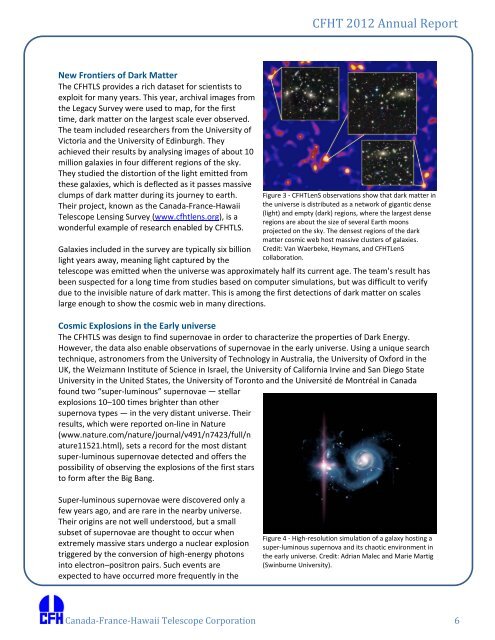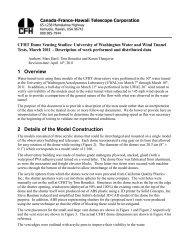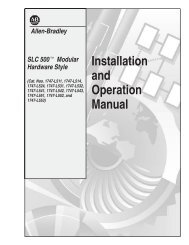2012 CFHT Annual Report - Canada France Hawaii Telescope ...
2012 CFHT Annual Report - Canada France Hawaii Telescope ...
2012 CFHT Annual Report - Canada France Hawaii Telescope ...
You also want an ePaper? Increase the reach of your titles
YUMPU automatically turns print PDFs into web optimized ePapers that Google loves.
<strong>CFHT</strong> <strong>2012</strong> <strong>Annual</strong> <strong>Report</strong><br />
New Frontiers of Dark Matter<br />
The <strong>CFHT</strong>LS provides a rich dataset for scientists to<br />
exploit for many years. This year, archival images from<br />
the Legacy Survey were used to map, for the first<br />
time, dark matter on the largest scale ever observed.<br />
The team included researchers from the University of<br />
Victoria and the University of Edinburgh. They<br />
achieved their results by analysing images of about 10<br />
million galaxies in four different regions of the sky.<br />
They studied the distortion of the light emitted from<br />
these galaxies, which is deflected as it passes massive<br />
clumps of dark matter during its journey to earth.<br />
Their project, known as the <strong>Canada</strong>‐<strong>France</strong>‐<strong>Hawaii</strong><br />
<strong>Telescope</strong> Lensing Survey (www.cfhtlens.org), is a<br />
wonderful example of research enabled by <strong>CFHT</strong>LS.<br />
Galaxies included in the survey are typically six billion<br />
light years away, meaning light captured by the<br />
Figure 3 ‐ <strong>CFHT</strong>LenS observations show that dark matter in<br />
the universe is distributed as a network of gigantic dense<br />
(light) and empty (dark) regions, where the largest dense<br />
regions are about the size of several Earth moons<br />
projected on the sky. The densest regions of the dark<br />
matter cosmic web host massive clusters of galaxies.<br />
Credit: Van Waerbeke, Heymans, and <strong>CFHT</strong>LenS<br />
collaboration.<br />
telescope was emitted when the universe was approximately half its current age. The team's result has<br />
been suspected for a long time from studies based on computer simulations, but was difficult to verify<br />
due to the invisible nature of dark matter. This is among the first detections of dark matter on scales<br />
large enough to show the cosmic web in many directions.<br />
Cosmic Explosions in the Early universe<br />
The <strong>CFHT</strong>LS was design to find supernovae in order to characterize the properties of Dark Energy.<br />
However, the data also enable observations of supernovae in the early universe. Using a unique search<br />
technique, astronomers from the University of Technology in Australia, the University of Oxford in the<br />
UK, the Weizmann Institute of Science in Israel, the University of California Irvine and San Diego State<br />
University in the United States, the University of Toronto and the Université de Montréal in <strong>Canada</strong><br />
found two “super‐luminous” supernovae — stellar<br />
explosions 10–100 times brighter than other<br />
supernova types — in the very distant universe. Their<br />
results, which were reported on‐line in Nature<br />
(www.nature.com/nature/journal/v491/n7423/full/n<br />
ature11521.html), sets a record for the most distant<br />
super‐luminous supernovae detected and offers the<br />
possibility of observing the explosions of the first stars<br />
to form after the Big Bang.<br />
Super‐luminous supernovae were discovered only a<br />
few years ago, and are rare in the nearby universe.<br />
Their origins are not well understood, but a small<br />
subset of supernovae are thought to occur when<br />
extremely massive stars undergo a nuclear explosion<br />
triggered by the conversion of high‐energy photons<br />
into electron–positron pairs. Such events are<br />
expected to have occurred more frequently in the<br />
Figure 4 ‐ High‐resolution simulation of a galaxy hosting a<br />
super‐luminous supernova and its chaotic environment in<br />
the early universe. Credit: Adrian Malec and Marie Martig<br />
(Swinburne University).<br />
<strong>Canada</strong>‐<strong>France</strong>‐<strong>Hawaii</strong> <strong>Telescope</strong> Corporation 6




![Documentation [PDF] - Canada France Hawaii Telescope ...](https://img.yumpu.com/26965302/1/190x245/documentation-pdf-canada-france-hawaii-telescope-.jpg?quality=85)







